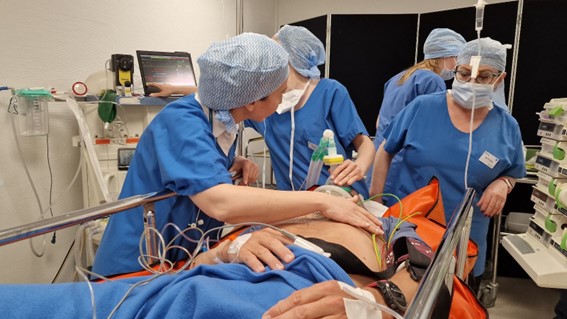Newsletter 2023
Newsletter September 2023: Anaesthesia and Intensive Care Crisis Simulation Masterclass - Helsinki Declaration through High Fidelity Simulation
Grenoble, France
11 – 12 May, 2023
Faculty:
Dr Daniel Arnal, Madrid, Spain
Dr Julien Picard, Grenoble, France
Dr Stefan Gisin, Switzerland
ESAIC held the fifth edition of our Anaesthesia and Intensive Care Crisis Simulation Masterclass in May: Helsinki Declaration through High Fidelity Simulation. During the COVID crisis, we innovated this course to be one of the few simulation events that could take place online, attracting participants from Australia, Saudi Arabia, Abu Dhabi and extensively from Europe. In 2023, we were back to a physical event. Grenoble has professional hi-fidelity simulation facilities and experienced faculty and is one of Europe’s leading simulation and trauma centres. We had attendees from Turkey, Switzerland, Romania, Belgium, and Kosovo.
“All the faculty were excellent in creating a safe-feeling learning environment for the participants. The debriefing and the discussion opportunity was great.”
Our faculty included our ESAIC Simulation Committee members and are all leaders in their field. They share their experience through teaching and debriefing.
The ESAIC Simulation Masterclass includes a 9-hour programme divided over two days with many interactive elements, including five simulation cases: two in Intensive Care, two in Theatre and one in Emergency Care.
During each case, a challenging clinical scenario is reproduced in a live, fully immersive environment, including a high-fidelity patient simulator (mannequin) controlled by experienced facilitators. During the trauma scenario, a real-life simulated patient brought extra realism to the scenario.
“The last Trauma scenario with a human simulating patient really impressive and added a great deal of realism”.
Each scenario is selected from recommendations outlined in the Helsinki Declaration on Patient Safety in Anaesthesiology. These include Pre-operative assessment and preparation, Difficult/failed intubation, Malignant Hyperthermia, Anaphylaxis, Local Anaesthetic Toxicity, Massive haemorrhage and Medication Errors. Realistic training in each of these scenarios is vital to be able to respond to real-life events in a timely and effective manner.
“Having had some experience with high fidelity scenarios, this course was really well built and the instructors did a good job selecting team leaders for each scenario”.
After each scenario, attendees worked with the faculty and colleagues to prepare the debriefing discussion. This was followed by a 30–40-minute debriefing offering constructive feedback. This session involved all participants.
What makes this masterclass special?
- Learning based on personal experience in a high-fidelity simulation centre.
- Experiencing crisis situations related to the Helsinki Declaration.
- Experience, practice and participate in debriefings in a safe environment.
- Conceptualise about non-technical skills and human factors in the face of the crisis.
- Acquire a set of practical tools for routine clinical practice.
Why Simulation?
ESAIC understands that training anaesthesiologists in teamwork, leadership, task management, communication and the other concepts included in Crisis Resource Management can improve patient safety through transversal competencies that would increase individual, team and organisational resilience.
There are new educational models that can help us improve patient safety. Simulation-based education is a learning technique used for almost four decades
in healthcare. Its main role is acquiring these skills and abilities within an environment as close to reality.
“Malignant hyperthermia – I have never had this experience (only read about it) so this made me realise what it would look like in a close-to-real-world scenario.”
Dr Gaba defines simulation “as a technique – not a technology – to replace or amplify real experiences with directed scenarios that reproduce the substantial aspects of the world in a totally interactive way”. Simulation is an excellent tool for adult learning because it requires experiential learning. Through debriefing, it also allows you to realise the need for change.











